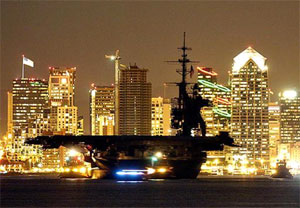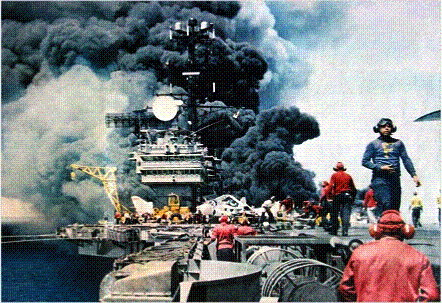To this day I can’t watch – actually hear – the scene in A Christmas Carol where Marley is about to appear to Ebinezer Scrooge on Christmas Eve without recalling that night. The junior officers of Attack Squadron 56 (VA-56) lived in two bunk rooms under the flight deck arresting gear. During flight operations the sounds of Air Wing Five’s jets dropping on to the deck, the run out of the arresting wires and the scraping reset of the cables was so routine you just hardly noticed after six months of day and night combat sorties over North Vietnam. But this was different – the nerve grinding screech was obviously something dragging across the deck that was big and out-of-place. Something was obviously very wrong.
 Today, now one hundred and one years after the first naval aviator to-be checked in to begin flight training at North Island, across the San Diego Harbor resides the USS Midway (CV-41), her operational service done, she is at peace. But it was not always that way. Designed and built out of the needs of World War II, she missed that war by days. But in the Vietnam War, Midway was one of only four carriers to receive the Presidential Unit Citation, 9unit equivalent of the Navy Cross). Her fighter pilots were responsible for the first air-air kill of the war on 17 June 1965 and the last kill on 12 January 1973. In the Christmas bombing raids that led to the end of the war, while Air Force B-52s struck at Hanoi, CAG 5’s Intruder pilots simultaneously struck Haiphong, and her attack pilots flew the last missions into North Vietnam. She stayed on the line until the last day, the last mission of that war. The ’72 war cruise set the record for most days on the line for any carrier in the war.
Today, now one hundred and one years after the first naval aviator to-be checked in to begin flight training at North Island, across the San Diego Harbor resides the USS Midway (CV-41), her operational service done, she is at peace. But it was not always that way. Designed and built out of the needs of World War II, she missed that war by days. But in the Vietnam War, Midway was one of only four carriers to receive the Presidential Unit Citation, 9unit equivalent of the Navy Cross). Her fighter pilots were responsible for the first air-air kill of the war on 17 June 1965 and the last kill on 12 January 1973. In the Christmas bombing raids that led to the end of the war, while Air Force B-52s struck at Hanoi, CAG 5’s Intruder pilots simultaneously struck Haiphong, and her attack pilots flew the last missions into North Vietnam. She stayed on the line until the last day, the last mission of that war. The ’72 war cruise set the record for most days on the line for any carrier in the war.
Charlie Hokansen, Ray Oswald and I were unwinding (maybe a secret Scotch in hand), having flown combat missions earlier, our day was done, or so we thought. Our other bunkroom-mate Mike “Manny” Bader was still out there, flying with our squadron commanding officer Lew Chatham. Even before “General Quarters, General Quarters, all hands man your battle stations” sounded, we three were running towards the Champ Ready Room., not just to find out what the hell was happening, but because that was our General Quarters station. What we found was not good. Almost immediately after entering the ready room, Skipper Lew followed – haggard, drenched in JP-5 jet fuel. Schoolboy and her people were in trouble.
Schoolboy, Midway’s call sign if you needed to talk to her in the goings and comings of “jousting with SAM and Charlie” was a warship, designed to go in harms way for the United States of America. From September 1945 to April 1992 neither Schoolboy’s crew or her airwing ever failed in that task. In the most demanding of missions, in the most demanding environment, Schoolboy owned the term reliant.
But then some days were harder than others.
On the night of 24 October, 1972 an A-6 Intruder returning from a combat mission over North Vietnam at close to maximum carrier landing – or “trap” – weight with two 500 pound bombs hung on its right outboard weapons station, landed successfully only to have the right axel shear off on contact with the flight deck. The aircraft tailhook disengaged from the arresting gear wire and the A-6 slid up the flight deck into previously parked aircraft. Sensing the near impact, the Bombadier Navigator ejected and was lost at sea. USS Midway – call sign Schoolboy -was on the verge of being the third carrier in the Vietnam war to have a major fire.
First was the 26 October 1966 fire on USS Oriskany (CV 34) killing 44 men, many who were veteran combat pilots who had flown raids over Vietnam a few hours earlier. Second, (picture), was a series of chain-reaction explosions and devastating fire on 29 July 1967 that killed 134 sailors and injured 161 on the USS Forrestal (CV-59), after an unusual electrical anomaly discharged a Zuni rocket on the flight deck. Damage exceeded $72 million (not including damage to aircraft).
were veteran combat pilots who had flown raids over Vietnam a few hours earlier. Second, (picture), was a series of chain-reaction explosions and devastating fire on 29 July 1967 that killed 134 sailors and injured 161 on the USS Forrestal (CV-59), after an unusual electrical anomaly discharged a Zuni rocket on the flight deck. Damage exceeded $72 million (not including damage to aircraft).
On Midway, the crash and rescue crew seeing the aircraft lose its wheel and begin skidding, immediately pulled out of their position behind the carrier’s super structure – the “island” – and began chasing the moving Intruder down the flight deck and began spraying it with fire retardent foam while the aircraft was still in motion. Their quick response quenched the fire in 90 seconds, therefore preventing ignition of fuel and ordance from multiple impacted aircraft. Five lives were lost, along with several aircraft. The AirWing Commander, struck by the A-6 wheel, almost lost his leg and was in critical condition but lived. Schoolboy launched combat sorties the next day against North Vietnam.
On a carrier at sea, different scripts call for different roles. Survival of the ship and its crew demand it. Survival when there’s no place to go is a team sport and quarterbacks change. In the case of fire, one of the most serious emergencies on a ship at sea, us college boy arrogant, God’s-gift-to-women, ne’er do well , flyboy-reason-the-ship-is-out-there, a-holes in speed jeans (anti-gravity or G- suits) report to our ready rooms so that most likely we can be assigned to a 19 year-old petty officer to man fire hoses on the flight deck – and might I importantly add, we most definitely take his direction. He knows a hell of a lot more about saving my precious than we do.
The mission of an aircraft carrier is to launch and recover combat aircraft, but its core strength is in getting past those moments when all teeters on the edge. This is the team moment, the CV moment, if you will, and in most incidents it is led and conducted not by the aviators but first by chief petty officers, and then by first, and second class petty officers. Knowledge, experience, adaptability, and an attitude derived from an understanding that this is their time, their moment. They, not the aviators are the difference makers. They know it and so do the aviators, from the Captain of the ship and the Airwing Commander down to the most fledgling aviator.
Essence of Winning and Losing: For a warship, survival on your “own terms” means carrying out your mission, in this case sending combat sorties over North Vietnam. If Midway/CAG 5 can’t execute, some other ship/airwing must, maybe on a day they were due for a well deserved stand down from the stress and grind of combat. It’s not just the pilots, flight deck crews barely get a break between the 12 hour cycles of launch and recovery. And it’s hot in the Gulf of Tonkin, but add jet blast … Days off are vital. The faith must be kept.
“It was a unanimous decision by the Captain and the CO’s to fly the next day. It is my recollection that every squadron CO, including me, flew on the 25th.” VA-56 Commanding Officer CDR Lew Chatham.
But it was a long way from survival to operations …
What follows are some of the stories of those participating in their own survival.




